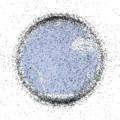Kessler Syndrome facts for kids
Kessler Syndrome (or an ablation cascade) is a thought-up situation made by the NASA scientist Donald J. Kessler in which the amount of space debris in orbit is large enough to cause space collisions to happen often. This would make space mostly unusable for years if it happened at an extreme level.
There is a satellite in orbit that is large and inactive, making it count as space debris, but it is in an orbit with a large amount of space debris. Two known objects get within 200m of it every year. This could cause a lot of space debris, inducing a domino effect with more collisions.
Avoiding Kessler Syndrome
Satellite manufacturers must demonstrate that their satellite can safely destroy itself or boost itself into a higher or lower orbit, known as a graveyard orbit, to avoid keeping unused satellites in common orbits for other satellites.
Related pages
- Space debris
- Gravity (movie), a 3D movie showing space debris and a form of Kessler Syndrome.
Images for kids
-
Space debris populations seen from outside geosynchronous orbit (GSO). There are two primary debris fields: the ring of objects in GSO and the cloud of objects in low Earth orbit (LEO).
-
Baker–Nunn cameras were widely used to study space debris.
See also
 In Spanish: Síndrome de Kessler para niños
In Spanish: Síndrome de Kessler para niños






